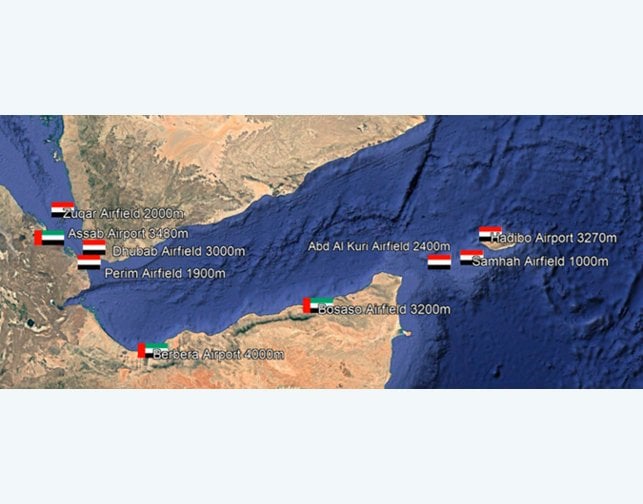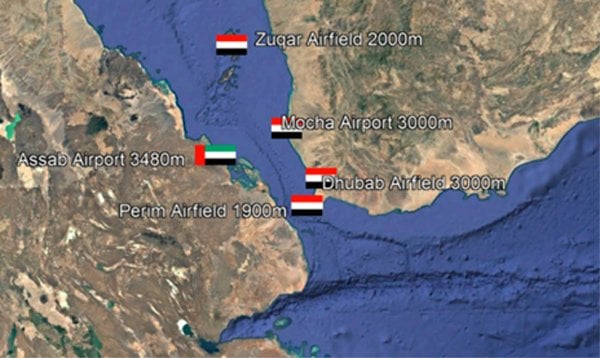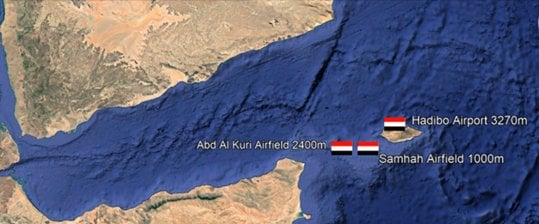Network of Airfields in Place Along Red Sea and Gulf of Aden

Since Houthi forces began attacking merchant vessels in the lower Red Sea and the Gulf of Aden, traffic using the Maritime Security Transit Corridor (MSTC) linking the Suez Canal to the Gulf and Asia has been much reduced. Despite receiving a pummeling from both American and Israeli forces, the Houthis' anti-shipping capability remains intact, ready to be reactivated at the whim of the Houthi leadership. A political solution, or a decisive turn in Yemen's civil war, which would put an end to hostile Houthi intentions, seems a remote prospect.
This is the context in which for the past few years a network of airfields has been constructed, which has the potential, not yet realized, to improve maritime security along the MSTC corridor, as part of a military component to contain the Houthis' threat to shipping.
Two clusters of airfields have been constructed, one dominating the southern end of the Red Sea and the Bab El Mandeb, and the other overlooking the southern flank of the MSTC in the Gulf of Aden. In between the two clusters, well-established Emirati bases at Berbera and Bosaso cover the southern flank of the MSTC at its western end.
Although there have been no official acknowledgements, these airfields appear to have all been constructed using Emirati resources. The contracting companies building the airfields are Emirati-linked. Shipping used to support construction on the islands has also been Emirati-linked. Because all the locations are remote and lack even basic infrastructure, construction materials, plant, and contractors have all had to be brought in over the beach. Who within the UAE has been sponsoring the construction effort, whether the Ministry of Defense or a humanitarian or aid organization, is unclear. But the lack of willingness to acknowledge ownership of the program inclines one to assume that it has had a security-linked sponsor.
All the remote islands and terrain on which the airfields have been built are controlled by the Southern Transition Council (STC) faction of the Yemeni Internationally Recognized Government (IRG). The STC relies heavily on the UAE for financial and military support, and to maintain the support of its ally is politically beholden to the UAE. Whether the program is a UAE initiative or an initiative of the STC, which the UAE is sponsoring, is unclear. The STC would not have the resources to carry out such a program on its own. Given decades of neglect of these remote islands by previous Yemeni governments, and the difficulties of supporting the small subsistence fishing communities that cling to life on the islands, on balance, the airfields program is unlikely to have been an initiative of the IRG.
The cluster of airfields in the southern Red Sea can be supported by the well-established Emirati base at Assab in Eritrea, or by the recently extended civil airport at Mocha on the Yemeni coast. The Perim airfield was completed in 2021 and sits astride the Bab El Mandeb strait at its narrowest part. The airfield at Zuqar on the northernmost of the Hanish Islands was constructed in a hurry; it was started in June this year and completed last week, the construction cutting through the middle of the primary village on the island. It overlooks the southerly approaches to the Houthi ports of Hodeidah, Salif and Ras Isa, 55 nautical miles to the North. Dhubab Airfield on the Yemeni coast south of Mocha was constructed between March 2023 and February 2025, and being in a remote and uninhabited area would appear to have a military purpose, a backup or alternative to the airfield on Perim. This is a sea area where the STC-aligned forces of General Tariq Saleh's National Resistance Front have made a number of successful interceptions of military equipment being smuggled in for the Houthis.

Airfields in the southern Red Sea (Airbus/CJRC)
Zuqar, Perim and Dhubab have relatively short runways, suitable for C130 transports and C295 transport/maritime surveillance or smaller aircraft, and for drones, but not suited for regular fighter/strike aircraft operations. All three are close to the sea, and thus would be difficult to defend, and none of the three have infrastructure to support sustained operations. They seem primarily designed to support visiting aircraft on quick turn rounds. Indeed no aircraft have been caught on satellite imagery at these airfields, with the possible exception of a drone sighted on the Perim airfield some time ago.
It is a similar story for the airfields in the Socotra Archipelago. These are likely to be supported from the well-established Emirati airbase at Hadibo. Both the airstrips on Abd Al Kuri and Samhah - which has yet to be finally completed - are austere runways without supporting infrastructure.

Airfields in the Socotra archipelago (Airbus/CJRC)
On February 16 this year, a medium transport aircraft may have been seen on the Abd Al Kuri runway. But the only regular visitor is a small transport aircraft that remains on the ground only for a few hours. It is probably the same 20m wingspan aircraft, which seems to be based at Hadibo.
At none of these airfields have fighter or strike aircraft ever been seen. Clearly, they could be used for diversions and contingencies, or mobilized quickly into forward operating bases should the need arise. But as yet, the airfields have made no obvious contribution to maritime security, save that the airfields in the Red Sea may have use in supporting the anti-smuggling activities of the National Resistance Forces. Conceivably, the airfields could be used to resupply intelligence collection facilities atop high points on the islands, but there is no evidence to support such conjecture. While the construction of the airfield network appears to be defense-sponsored, little defense utility or maritime security benefit for the investment has yet become apparent.
